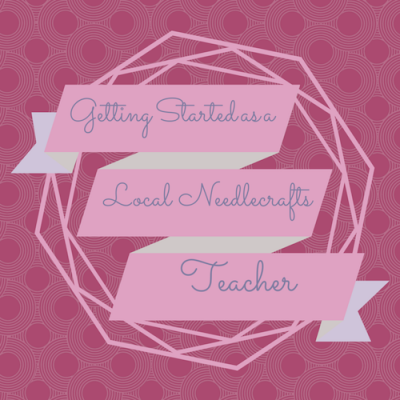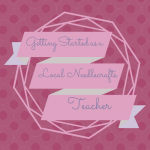In my last post of this series on getting started as a local needlecrafts teacher, I’m focusing on how to stay creative and current.
 Update: This series is a great introduction to teaching, but since I originally wrote it in 2011, it has become outdated. If you’re looking for a more robust (and updated) approach to teaching, check out my book, Make Money Teaching Crochet: Launch Your Business, Increase Your Side Income, Reach More Students.
Update: This series is a great introduction to teaching, but since I originally wrote it in 2011, it has become outdated. If you’re looking for a more robust (and updated) approach to teaching, check out my book, Make Money Teaching Crochet: Launch Your Business, Increase Your Side Income, Reach More Students.
Current needlecraft trends
There are many reasons to stay abreast of the latest trends in the needlecrafts you teach.
- Student interest. Students are often interested in whatever technique, styles/patterns, or celebrities are “hot” within the craft industry. This may create an opportunity for a new class. Even if you have no interest in doing or teaching what is on trend, it helps to have an awareness of the trend’s existence. This also makes you seem more connected to the industry as a teacher.
- Your own interest. Especially if you teach only beginners, you may start to stagnate. How many variations of straight rows of single crochet can you come up with, after all? Trying new techniques, designs, or yarns will help keep you “fresh” so you can continue to display that passion for the craft to your students.
- Venue interest. Many yarn shops, events, and organizations where you might want to teach will be interested in offering new and interesting classes.
- Keeping your materials updated. If you teach an ongoing class over a long period of time, you will need new material (content, projects, handouts) to inject into the classes, or you may lose some of your long standing students who are bored with the same old stuff.
But how do you figure out what the trends are?
- General fashion or home decoration trends. There are general trends in fashion, home decor, and lifestyles which translate easily into handmade needlecrafts. From a quick glance at the fashion, home decor, lifestyle, or women’s interest magazine sections in a bookstore, you will have a general idea of the colors, weights of fabric, styles, and issues that are currently on trend. If you are lucky enough to live in a place like New York City as I do, you can also take a gander at what people are wearing in the streets and on subways. If bulky scarves are in, for example, perhaps you want to familiarize your students with knitting with two strands of yarn. If you see that there is a growing interest in eco-friendly products, for example, you can introduce your students to natural fiber yarns and how to care for them. If this is too abstract for you, checking out the latest issues of the needlecrafts magazines will also give you an idea of what is current in the craft you are teaching.
- Tools and techniques. What are local stores and online vendors selling now in terms of tools? It wasn’t too long ago that hooks and needles were only available in metal or plastic. Now you see wood everywhere. Maybe your sock knitting class could include a section about the types of needles now available and which might be best for a particular project or technique. If you start seeing more hairpin lace looms or afghan crochet hooks, it is a good sign that these techniques are on the rise. Perhaps you might offer a beginner class or develop a project for your students.
- Keep current in your needlecraft industry. This can include joining professional organizations, guilds, and social networking sites as well as reading the blogs or websites of classic and emerging designers in your field. The Craft Yarn Council recently published their survey of over 5,000 knitters and crocheters, which includes information about favorite projects.
- Amazon.com. If you Google “Amazon bestsellers (insert name of needlecraft here),” you can get a list of ranked books currently selling in that category. Some of these books will be classics and others will be newer.

Let’s take a quick look at the titles on Amazon’s current list of knitting bestsellers.
- Knit Your Own Royal Wedding
- 100 Flowers to Knit and Crochet
- 60 Quick Baby Knits
- Knit Your Own Dog
- Spud and Chloe at the Farm
- 75 Birds, Butterflies, & Little Beasts to Knit and Crochet
- Entrelac
- Sock Yarn One-Skein Wonders
- The Principles of Knitting (UC note: This is not yet released new edition of an out-of-print classic.)
- Stitch ‘N Bitch: The Knitter’s Handbook
- Knitting Block by Block
- The Knitting Answer Book
- Mastering Color Knitting
- Toe-Up 2-at-a-Time Socks
- Astounding Knits!
- A Knitter’s Home Companion
- Knit Kimono Too
- Socks from the Toe Up
- Modern Top-Down Knitting
- Teach Yourself VISUALLY Knitting
In looking over the list, you can see that there are six books about quick or small projects (#1, #2, #3, #4, #6, #8), two books about socks (what a surprise!) (#14 & #18), two books about contemporary clothing patterns (#17 and #19), and two books about amigurumi/dolls (#1 & #4). There is a mix between project books and technique books (#7, #11, #13).
Just a quick look at this list can give you some great ideas for classes. For example, you can see that small projects are what people are currently interested in. This can be due to speed, the lower cost of materials, or the portability. Also, both sock books are about toe-up socks rather than other types of construction. If you check the list again in 3 months, some of the classics and basics will remain, but many of the others will have changed.
Staying creative
I make an effort to take at least one class with another needlecrafts teacher each year. Why? For one, I can learn a lot about my own teaching strengths and weaknesses by observing another teacher as well as by observing myself as a student. When do I get bored? How long is too long to focus on one activity? How does the teacher allow more advanced students to move on? How does the teacher deal with struggling students?
I also try to learn new skills – whether this is a new technique in a familiar craft or an entirely new craft. For example, when I started quilting, I developed a much better understanding of the design elements of a blanket, sizing, and color theory. I could use these skills in my personal crocheting, for example, as well as in my classes.
It also helps to complete some projects! While I try not to overwhelm beginner students by showing them everything I’ve made, more advanced students may become interested in a certain technique, pattern, or project after seeing you complete it.
Do you have other suggestions for keeping the creative spirit alive?

